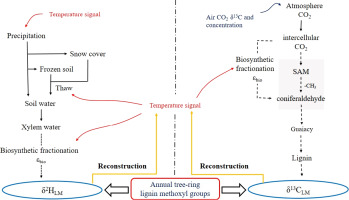Science of the Total Environment ( IF 9.8 ) Pub Date : 2020-04-08 , DOI: 10.1016/j.scitotenv.2020.138558 Yabo Wang 1 , Xiaohong Liu 2 , Tobias Anhäuser 3 , Qiangqiang Lu 4 , Xiaomin Zeng 1 , Qiuliang Zhang 5 , Keyi Wang 1 , Lingnan Zhang 1 , Yu Zhang 1 , Frank Keppler 6

|
Stable isotopes in wood lignin methoxyl groups (δ2HLM and δ13CLM values) have been suggested as valuable complementary paleoclimate proxies. In permafrost forests, tree growth is influenced by multiple factors, however temperature appears to have the strongest impact on tree growth and, therefore, on carbon cycling. To test whether δ2HLM and δ13CLM values of trees from permafrost regions might record climate parameters, two dominant tree species (Larix gmelinii, larch, and Pinus sylvestris var. mongolica, pine) collected from a permafrost forest in China's Greater Hinggan Mountains, were investigated. The two tree species larch and pine covered time spans of 1940 to 2013 and 1870 to 2013, respectively. Results showed significant correlations of pine and larch δ2HLM values and larch δ13CLM values with temperatures and in particular with the mean temperature of the growing-season from April to August. However, only weak correlations of δ2HLM and δ13CLM values with moisture conditions, such as precipitation amount and relative humidity were observed. In addition, species specificity in the climatic response was most obvious for δ13CLM values. Compared to a temperature reconstruction based on tree ring width, pine δ2HLM–based reconstruction showed strongest spatial correlations with regional temperature. Therefore, δ2HLM values might be a promising proxy to reconstruct growing-season temperatures in permafrost regions.


























 京公网安备 11010802027423号
京公网安备 11010802027423号